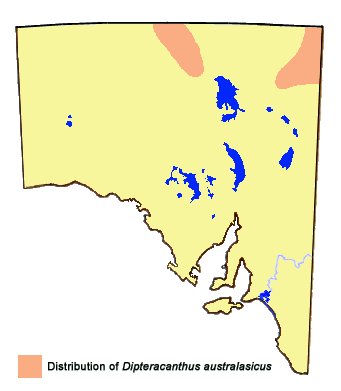-
Larval Food Host
-
In Australia, the preferred hostplants occur in the Acanthaceae family, but they also use
a small legume (Fabaceae) in adjacent Papua New Guinea. Those hostplants suitable for
South Australian conditions include Dipteracanthus australasicus and
*Ruellia sp (tropical types) (Acanthaceae).
Overseas the hostplants can include *Mimosa (sensitive plant) (Mimosaceae),
*Oxalis corniculata (Oxalidaceae), and *Tribulus (caltrops) (Zygophyllaceae).
The latter two plants are locally common inland species where water is available. Another
Acanthaceae plant that grows in similar habitat to Dipteracanthus is Rostellularia,
and this plant may also eventually be found to be a hostplant. The larvae eat the young
fruit or immature seeds within developing seed pods.
-
Larval Attendant Ant
-
Larvae are usually not attended by ants, but may occcur in association with small black ants.
-
Eggs
-
Very small, white, hemispherical, strongly flattened top and bottom,
slightly depressed on top with a small darker central micropylar area.
Ornamented with a coarsely reticulated pattern on the side, which
becomes finer on top. The reticulation facets are generally of hexagonal
pattern on the sides, but become irregular shaped on top. Eggs are laid
singly on the buds and calyx portion of the flowers of the host plants.
Eggs hatch in about 5 days.
-
Larvae
-
The mature larvae are about 7-8 mm long, onisciform (slater shaped) with an indistinct
longitudinal dorsal furrow. The body has some short lateral and dorsal hairs, and is
covered in numerous, minute secondary setae that impart a scabrous appearance to the
larvae. The posterior dorso-lateral organs are well developed. In Australia the
reported body colour is pale green, with an intermittent red longitudinal dorsal
line edged white or pink, and a pink dorsal patch behind the head. The posterior
end has a red lateral line. In other countries the larvae can be entirely green.
Larvae feed openly during the day. The presence of larvae on the host plants is readily
discernible by tiny holes in the buds and seed pods. The larval period can be about
a week in hot areas.
-
Pupae
-
Long cylindrical, rounded anteriorly, abdomen elongate, posteriorly rounded,
about 6 mm long, mostly smooth but with numerous short colourless hairs
covering the dorsal surface. Pale green coloured with a darker dorsal line,
and there is a dorsal pair of black spots located at the anterior end of the abdomen.
Attached by anal hooks and a central girdle, usually to some silk secured green part
of the host plant. The pupal period can be as short as 8 days, but the pupa probably
has the ability to aestivate to adjust to the seasonal growth of its host plants.
-
Flight Period in South Australia
-
In tropical areas the butterfly has been recorded flying throughout the year,
but its main flight generally corresponds to the flowering of its preferred
hostplants. In the southern parts of its range it tends to be more common
during autumn. A brood can be completed in three weeks. It has not been
reported how it overwinters or what it does when the hostplants stop flowering.

-
Distribution
-
The butterfly normally occurs in the moist tropical and subtropical areas,
wherever its hostplants occur in adequate density. It may be partly nomadic
(typical of the Polyommatini group of lycaenids) during seasons of good
monsoon rain and is reported to occur in the Alice Springs area of Central
Australia although that report requires further confirmation.
The butterfly has not yet been recorded from South Australia. Its Dipteracanthus
host plants occur along the Cooper and Finke Rivers floodplain systems in the Far North
of SA and there is a faint possibility that small semi-resident populations of the
butterfly may eventually be found in those areas after either good inland rains or
after ephemeral flood waters have receded. Breeding stocks would be expected to be
replenished from interstate, with the butterflies following the major creek-lines down
into South Australia.

-
Habitat
-
Its known Australian hostplants are tropical to subtropical perennial types that usually
occur in wetland or floodplain areas, or areas with assured intermittent rain.
-
Conservation Status in South Australia
-
Locally common in breeding areas.
-
Threats
-
No major threats.
-
Conservation Strategy
-
None required.


